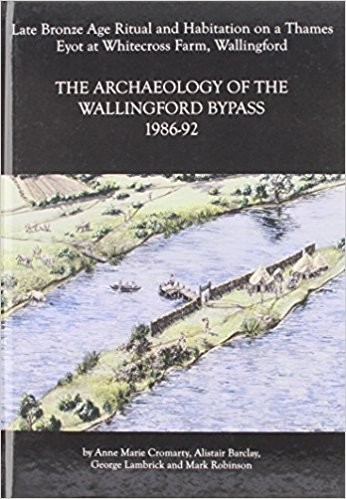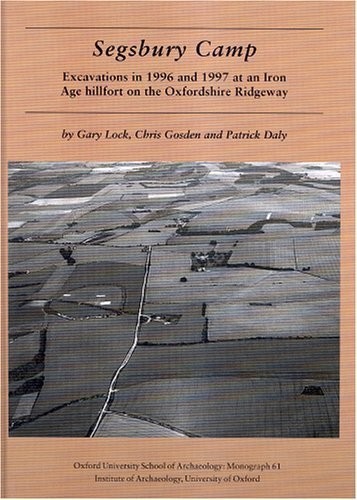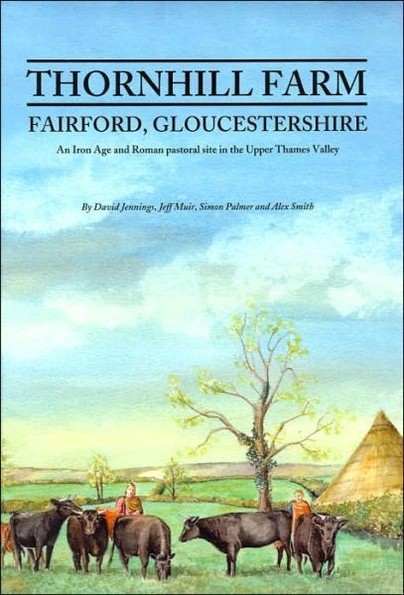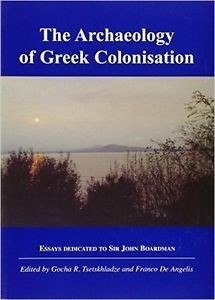The Oxford School of Archaeology was established in 2000, as the successor to the Committee for Archaeology. The School is comprised of the Institute of Archaeology (located on Beaumont Street) and the Research Laboratory for Archaeology & the History of Art (located in the Dyson Perrins Building on South Parks Road).

Format: Hardback
Pages: 470
ISBN: 9780954962753
Pub Date: 12 Apr 2007
Series: Thames Valley Landscapes Monograph
Illustrations: b/w and col illus t/out
Description:
The gravel terraces of the river Thames have revealed a wealth of archaeological information about the evolution of the landscape of the region, the development of the settlement pattern, and past human occupation. Much of this has come to light in the course of gravel quarrying, which has been so extensive that the Thames Valley now provides one of the richest resources of archaeological data in the country. This volume provides an up to date overview of the archaeological evidence from the valley for the late Iron Age, Roman and Anglo-Saxon periods, broadly speaking the first millennium AD.
The area studied in detail comprises the Upper Thames Valley, from the source of the river to the Goring Gap, and the Middle Thames Valley, from the Goring Gap to the start of the tidal zone at Teddington Lock. A summary of evidence for the character of the river and the vegetation and environment of its floodplain is followed by a detailed account of the evolving settlement pattern as currently understood from archaeological evidence. The authors then consider what archaeology can reveal about the late Iron Age, Roman and Anglo-Saxon populations of the valley, and their changing lifestyles, culture, identities and beliefs. This is followed by a review of the evidence for production, trade, transport and communication, and the archaeology of power and politics. The volume concludes with a discussion of the state of knowledge today and its limitations, and emerging themes and problem areas for future research.

Format: Hardback
Pages: 436
ISBN: 9780947816742
Pub Date: 31 Mar 2007
Series: Thames Valley Landscapes Monograph
Illustrations: many col pls and illus, CD-Rom
Description:
The Cotswold Water Park Project is a landscape study centred upon parts of the Upper Thames Valley within what is now the Cotswold Water Park. The report is based upon four key excavated rural settlements, the most extensive being that at Claydon Pike, which dated primarily from the middle Iron Age to the late Roman period. A number of middle Saxon burials were also found.
The other Water Park settlements dated to the late Iron Age-Roman period and the 2nd to 3rd century AD. The report has incorporated the results of these excavations into a wider synthesis of landscape development in the region, including aspects of material culture, environment and the economy.

Format: Paperback
Pages: 368
ISBN: 9780947816223
Pub Date: 25 May 2006
Series: Anglo-Saxon Studies in Archaeology and History
Illustrations: b/w illus
Description:
Anglo-Saxon Studies in Archaeology and History is an annual series concerned with the archaeology and history of England and its neighbours during the Anglo-Saxon period. Volume 13 can be said to be truly interdisciplinary, carrying papers from diverse areas such as place-name studies, art history, historiography and archaeology. A strong theme in this issue is the early Anglo-Saxon period, with a range of papers touching on aspects of migration.
Another shared theme is the complexity and multiplicity of meaning in iconography and art, whilst military strategy and military kit take this volume into the Late Saxon period.

Format: Hardback
Pages: 264
ISBN: 9780947816674
Pub Date: 12 Mar 2006
Series: Thames Valley Landscapes Monograph
Illustrations: 70 illustrations, 22 plates
Description:
The site at Whitecross Farm, including timber structures located on the edge of the eyot, and a substantial midden and occupation deposit has been securely radiocarbon-dated to the late Bronze Age. The late Bronze Age artefact assemblages are suggestive of a high-status site, with a range of domestic and ritual activities represented. The bank of the Grim's Ditch earthwork was found to have preserved evidence of earlier settlement, dating to the Neolithic and Bronze Age, and a sequence of cultivation, including ard marks and 'cord-rig' cultivation ridges.
Pottery and radiocarbon analysis dated the earthwork to the end of the late Iron Age or the early Roman period. A multi-period settlement, consisting of pits, a waterhole, postholes, gullies and field systems, was identified at Bradford's Brook, Cholsey. The main periods represented are late Bronze Age and Romano-British, while a small quantity of Saxon pottery indicates limited Saxon activity. A large pit containing late Bronze Age pottery, a cattle skull, waterlogged wood and plant remains, a complete loomweight and flint flakes has been interpreted as a waterhole. A series of radiocarbon dates were obtained for deposits within this feature. All three sites are discussed individually as well as within their local, regional and national contexts. Chapter 7 provides an overall discussion of later Bronze Age themes that have arisen through the excavation and analysis of these sites.

Format: Hardback
Pages: 390
ISBN: 9780954962708
Pub Date: 02 Feb 2006
Series: Oxford University School of Archaeology Monograph
Illustrations: 267 b/w illus
Description:
Le Yaudet (in Brittany, France) is a promontory of granite commanding the estuary of the river Léguer down-river from the modern town of Lannion (Côtes d'Armor). It has long been known as the 'Old Town' ( Civitas vetus in Latin documents and Coz Yaudet in Breton) and Iron Age, Roman and medieval finds have been made from time to time over the last two centuries. A programme of research excavations began in 1991 and continued annually until 2002.
The results of the work show the site to have been in use almost continuously from the early prehistoric period. This is the second volume and deals with the Prehistoric period, continuing up until the end of the Gallic Empire.

Format: Hardback
Pages: 158
ISBN: 9780947816681
Pub Date: 10 Oct 2005
Series: Oxford University School of Archaeology Monograph
Description:
This volume describes the two seasons of excavation at Segsbury Camp which form a part of Oxford University's Hillforts of the Ridgeway Project . It contains background material and a series of interpretations of the site at different scales finishing with a discussion of the Lambourn Downs landscape in later prehistoric and Romano-British times. The evidence suggests that the large hillfort of Segsbury was used during the period 6th to 2nd century BC but was not densely and permanently occupied.
It also seems that Segsbury was constructed in a new and previously unused area of the Downs. Alternative interpretations are explored within a framework of trying to understand what is meant by 'community' and how Segsbury interacted with other hillforts in the area. The detail provided by the excavation of several hillforts on the Lambourn Downs suggests that they were different forms of monument and argues against trying to understand hillforts as a single category.

Format: Hardback
Pages: 520
ISBN: 9780947816667
Pub Date: 01 Jun 2005
Series: Thames Valley Landscapes Monograph
Illustrations: 179 b/w illus, 31 ls
Description:
Excavations conducted between 1981 and 1986 in advance of gravel extraction in Gravelly Guy field, Stanton Harcourt, Oxfordshire, revealed archaeological evidence spanning from the Neolithic through to the Saxon period. Neolithic and early Bronze Age activity is represented by pit scatters and a series of ring ditches with associated burials. The Iron Age and early Roman periods witnessed the continuous development of a linear settlement, consisting of a dense area of pits, gullies, circular structures, four-posters and boundary ditches in the mid to late Iron Age phase and a series of rectilinear enclosures and unusual 'ramped hollows' and wells in the late Iron Age/early Roman period.
Excavation of a section at the junction of the floodplain and the gravel terrace has also provided information regarding the changing land use and contemporary environment in the vicinity of the site. Gravelly Guy remains one of the most thoroughly excavated sites of this period in the Thames Valley. As well as the vast amount of structural evidence, the considerable quantities of artefacts and environmental information recovered, together with a series of ten radiocarbon dates, have resulted in a detailed study of the site, its position in the landscape and relationship to the contemporary archaeology of the surrounding area.

Format: Hardback
Pages: 198
ISBN: 9780947816629
Pub Date: 13 Apr 2005
Series: Thames Valley Landscapes Monograph
Illustrations: many b/w illus, some col illus
Description:
Archaeological investigations at Harding's Field, Chalgrove, revealed the remains of one of the most complete examples of a moated medieval manor yet excavated in England. Evidence of a pre-moat occupation dating from the first half of the 13th century, which may not have been seigneurial, was succeeded in the mid 13th century by the construction of the moated manor house. The documentary evidence indicates that this house belonged to the Barentins, a prominent Oxfordshire family.
The manor underwent considerable alterations and improvements during the following 200 years, particularly during the early part of the 14th century and, to a lesser extent, in the late 14th and early 15th century. It passed out of the hands of the Barentin family shortly before it was demolished in the late 15th century.

Format: Hardback
Pages: 200
ISBN: 9780947816728
Pub Date: 15 Jul 2004
Series: Thames Valley Landscapes Monograph
Illustrations: many b/w illustrations
Description:
For over 500 years, from the middle Iron Age to the early Roman period, the 1st gravel terrace of the river Thames at Thornhill Farm appears to have been lived in and worked as a cattle ranch. Extensive excavations by Oxford Archaeology between 1986 and 1989 revealed large parts of the settlement, including paddocks, stock enclosures and droveways, all designed to control and manage the herds of animals. Evidence for domestic houses points to small family groups living at the site and tending to the livestock.
The surrounding gravel terraces and floodplain would have formed open pastureland, upon which lay a number of other settlements, some of which were also operating specialist pastoral economies. The settlement at Thornhill Farm was constantly being developed and remodelled until the early 2nd century AD, when it was replaced by a series of trackways and some of the earliest hay meadows in Britain. What happened to the inhabitants of Thornhill Farm at this time is unknown, but it seems likely that the whole settlement was subsumed into a larger agricultural estate based at neighbouring Claydon Pike. The excavations at Thornhill Farm formed part of a co-ordinated archaeological response to the threat posed by gravel extraction during the creation of the Cotswold Water Park. This book presents the results of this phase of work, and discusses the significance of the site within the local and regional landscape.

Format: Paperback
Pages: 160
ISBN: 9780947816612
Pub Date: 20 Apr 2004
Illustrations: 31 b/w figs, 3tbs
Description:
This collection of eight essays on the archaeology of Greek colonisation, dedicated to Sir John Boardman on the occasion of his retirement, has now been reprinted in paperback. Greek colonisation continues to be a much debated topic among ancient historians and archaeologists of the Mediterranean region. These classic essays focus on archaeological research, but they consider themes relevant to archaeologists and historians alike, including: the motivation for colonisation, identity, and social integration; technology and trade; collaboration, competition and conflict.
First published in 1994, the new edition includes a new preface and corrections. Contributors: A M Snodgrass, M R Popham, D Ridgway, J N Coldstream, B B Shefton, F De Angelis, G R Tsetskhladze, and J Boardman.

Format: Hardback
Pages: 302
ISBN: 9780947816599
Pub Date: 08 Apr 2004
Series: Oxford University School of Archaeology Monograph
Illustrations: 142 b/w illus and pls
Description:
Le Yaudet is a promontory of granite commanding the estuary of the river Léguer down-river from the modern town of Lannion (Côtes d'Armor). It has long been known as the 'Old Town' (Civitas vetus in Latin documents and Coz Yaudet in Breton) and Iron Age, Roman and medieval finds have been made from time to time over the last two centuries. A programme of research excavations began in 1991 and continued annually until 2002.
The results of the work show the site to have been in use almost continuously from the early prehistoric period. This publication is the first of four volumes documenting the fascinating discoveries made at this important site. Written entirely in French, it provides an overview of the site, giving insight into the physical geography, the town's history prior to excavation, and the archaeological research programme. It is lavishly illustrated with many photographs and line drawings.

Format: Paperback
Pages: 180
ISBN: 9780904220339
Pub Date: 17 Jan 2004
Series: Thames Valley Landscapes Monograph
Illustrations: illus
Description:
In 1995 a second phase of excavations was undertaken by Oxford Archaeological Unit (OAU) at Reading Business Park in advance of development. This volume reports on the occupation evidence they found dating to the Neolithic, Bronze Age and medieval periods. The Neolithic features included an unusual segmented ring ditch, and a number of pits and postholes, with associated flint assemblages dating to the late Neolithic.
A field system, composed of rectangular boundary ditches, was laid out in the area prior to the establishment of the late Bronze Age settlement. The evidence for the late Bronze Age settlement included five roundhouses, and a number of post-built structures. The excavators also found numerous deposits of burnt flint that were made in one area in the later Bronze Age, and over time these grew into a substantial and unusually large elongated burnt mound. The authors discuss the origin of these deposits, together with the management of the overall landscape in the later Bronze Age.

Format: Hardback
Pages: 200
ISBN: 9780947816582
Pub Date: 01 Dec 2003
Series: Oxford University School of Archaeology Monograph
Illustrations: 76 b/w figs, 12 tbs
Description:
These seventeen papers were presented at a conference on African archaeology, held at St Hugh's College, Oxford, in April 2002. The topics span nineteen countries, from Morocco in the far northwest of the continent to Lesotho, Madagascar and South Africa in the south, from Mauritania in the west to Ethiopia and Kenya in the east. Together they show the strength of research in African archaeology being undertaken at the present time by British-based academics, and the relevance of Africa to a whole range of archaeological debates, including: early hominid evolution and the recent appearance and expansion of our own species, palaeoenvironmental reconstruction, the early development of food-production, the development of metallurgy, the formation of complex societies, and the sociopolitical impacts of long-distance trade.

Format: Hardback
Pages: 260
ISBN: 9780947816797
Pub Date: 23 May 2003
Series: Thames Valley Landscapes Monograph
Illustrations: many b/w illus
Description:
The Upper Thames Valley is an important area for prehistoric monuments and has one of the highest concentrations of cursuses, distinctive linear or elongated earthworks, in Britain. In the 1980s the Oxford Archaeological Unit along with the Abingdon Area Archaeological and Historical Society had the opportunity to extensively investigate one of these sites at Drayton. This site has produced many significant results for our present understanding of the date, construction and use of cursus monuments on the lowland river gravels of Britain.
This volume reports on the excavations at Drayton, and includes an account of small-scale excavations undertaken at the Lechlade cursus by OAU and Lance and Faith Vatcher. It also provides a gazetteer of known cursus monuments in the Upper Thames Valley.
In Harvey's House and in God's House
Format: Paperback
Pages: 46
ISBN: 9780904220100
Pub Date: 01 Sep 2002
Illustrations: with 18 figs & 5 illus.
Description:
This volume brings together the results of two evaluation and excavation projects undertaken by Oxford Archaeological Unit at Eynsham Abbey between 1991 and 1993. It reports on the medieval moated site and associated fishponds, the late Anglo-Saxon/medieval abbey, and finds, together with discussion.

Format: Paperback
Pages: 120
ISBN: 9780947816537
Pub Date: 01 Dec 2000
Illustrations: 75 illus
Description:
This volume builds upon the copious and varied research on villa mosaics in Roman Britain and evaluates it within the context of elite social life in the 4th century AD. It argues that the mosaics were an integral part of the rich lifestyle of the elite in this period and played an important role in defining their status. Yet these symbols of power were apparently no longer valued to the same degree by the end of the 4th century.
In a priod of increasing social and economic instability, the mosaics were one element in an elite lifestyle which was ultimately to prove socially diversive. In this wide-ranging study, Scott considers the significance and long-term impact of the artistic choices made by villa owners.
















